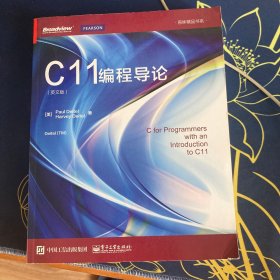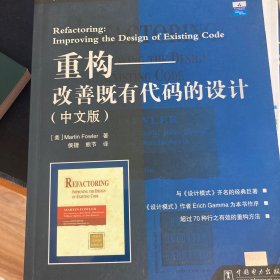
C11编程导论(英文版)
¥ 30 3.4折 ¥ 89 九五品
仅1件
天津西青
认证卖家担保交易快速发货售后保障
作者[美]Paul(保罗·戴特尔)、Harvey Deitel(哈维·戴特尔) 著
出版社电子工业出版社
出版时间2016-03
版次1
装帧平装
上书时间2024-04-14
- 最新上架
商品详情
- 品相描述:九五品
图书标准信息
- 作者 [美]Paul(保罗·戴特尔)、Harvey Deitel(哈维·戴特尔) 著
- 出版社 电子工业出版社
- 出版时间 2016-03
- 版次 1
- ISBN 9787121273162
- 定价 89.00元
- 装帧 平装
- 开本 16开
- 纸张 胶版纸
- 页数 476页
- 字数 571千字
- 正文语种 英语
- 丛书 原味精品书系
- 【内容简介】
-
《C11编程导论英文版》沿用了Deitel特色的“程序实况解说”,深入探讨了C语言和C标准库。通过完整的语法着色、代码高亮、代码演练和程序输出,全面地介绍了测试程序的概念。《C11编程导论英文版》汇集约5000行C代码和数百个开发技巧,将帮助你构建强大的应用程序。《C11编程导论英文版》的内容包括构建自定义数据结构、标准库等;并选择了C11标准的一些新特性,如多线程来帮助你为目前的多核系统编写高性能的应用程序;C语言安全编程部分展示了如何让你编写的程序具有更好的鲁棒性,不易受到攻击。
《C11编程导论英文版》适合具有一定高级语言编程背景的程序员阅读。
- 【作者简介】
-
Paul Deitel,Deitel & Associates有限公司的CEO兼CTO,毕业于麻省理工学院,主修信息技术。在Deitel & Associate有限公司公司工作的过程中,他已经为行业、政府机关和军队客户提供了数百节编程课程,这些客户包括思科、IBM、西门子、Sun Microsystems、戴尔、Fidelity、肯尼迪航天中心、美国国家强风暴实验室、白沙导弹试验场、Rogue Wave Software、波音公司、SunGard Higher Education、北电网络公司、彪马、iRobot、Invensys等。他和本书的合著者Harvey M. Deitel博士是全球畅销编程语言教材、专业书籍和视频的作者。
Harvey Deitel博士,Deitel & Associates有限公司的董事长和首席战略官,在计算机领域中拥有50多年的经验。Deitel博士获得了麻省理工学院电子工程(学习计算)的学士和硕士学位,并获得了波士顿大学的数学博士学位(学习计算机科学)。他拥有丰富的行业和大学教学经验,在1991年与儿子Paul Deitel创办Deitel & Associates有限公司之前,他是波士顿大学计算机科学系的主任并获得了终身任职权。Deitel博士为很多大公司、学术研究机构、政府机关和军方提供了数百场专业编程讲座。Deitel的出版物获得了国际上的认可,并被翻译为繁体中文、简体中文、韩语、日语、德语、俄语、西班牙语、法语、波兰语、意大利语、葡萄牙语、希腊语、乌尔都语和土耳其语。
- 【目录】
-
前言
1 Introduction
1.1 Introduction
1.2 The C Programming Language
1.3 C Standard Library
1.4 C++ and Other C-Based Languages
1.5 Typical C Program Development Environment
1.5.1 Phase 1: Creating a Program
1.5.2 Phases 2 and 3: Preprocessing and Compiling a C Program
1.5.3 Phase 4: Linking
1.5.4 Phase 5: Loading
1.5.5 Phase 6: Execution
1.5.6 Standard Input, Standard Output and Standard Error Streams
1.6 Test-Driving a C Application in Windows, Linux and Mac OS X
1.6.1 Running a C Application from the Windows Command Prompt
1.6.2 Running a C Application Using GNU C with Linux
1.6.3 Running a C Application Using GNU C with Mac OS X
1.7 Operating Systems
1.7.1 Windows―A Proprietary Operating System
1.7.2 Linux―An Open-Source Operating System
1.7.3 Apple’s Mac OS X; Apple’s iOS ? for iPhone ? , iPad ? and iPod Touch ? Devices
1.7.4 Google’s Android
2 Introduction to C Programming
2.1 Introduction
2.2 A Simple C Program: Printing a Line of Text
2.3 Another Simple C Program: Adding Two Integers
2.4 Arithmetic in C
2.5 Decision Making: Equality and Relational Operators
2.6 Secure C Programming
3 Control Statements: Part I
3.1 Introduction
3.2 Control Structures
3.3 The if Selection Statement
3.4 The if … else Selection Statement
3.5 The while Repetition Statement
3.6 Class Average with Counter-Controlled Repetition
3.7 Class Average with Sentinel-Controlled Repetition
3.8 Nested Control Statements
3.9 Assignment Operators
3.10 Increment and Decrement Operators
3.11 Secure C Programming
4 Control Statements: Part II
4.1 Introduction
4.2 Repetition Essentials
4.3 Counter-Controlled Repetition
4.4 for Repetition Statement
4.5 for Statement: Notes and Observations
4.6 Examples Using the for Statement
4.7 switch Multiple-Selection Statement
4.8 do … while Repetition Statement
4.9 break and continue Statements
4.10 Logical Operators
4.11 Confusing Equality ( == ) and Assignment ( = ) Operators
4.12 Secure C Programming
5 Functions
5.1 Introduction
5.2 Program Modules in C
5.3 Math Library Functions
5.4 Functions
5.5 Function Definitions
5.6 Function Prototypes: A Deeper Look
5.7 Function Call Stack and Stack Frames
5.8 Headers
5.9 Passing Arguments By Value and By Reference
5.10 Random Number Generation
5.11 Example: A Game of Chance
5.12 Storage Classes
5.13 Scope Rules
5.14 Recursion
5.15 Example Using Recursion: Fibonacci Series
5.16 Recursion vs. Iteration
5.17 Secure C Programming
6 Arrays
6.1 Introduction
6.2 Arrays
6.3 Defining Arrays
6.4 Array Examples
6.5 Passing Arrays to Functions
6.6 Sorting Arrays
6.7 Case Study: Computing Mean, Median and Mode Using Arrays
6.8 Searching Arrays
6.9 Multidimensional Arrays
6.10 Variable-Length Arrays
6.11 Secure C Programming
7 Pointers
7.1 Introduction
7.2 Pointer Variable Definitions and Initialization
7.3 Pointer Operators
7.4 Passing Arguments to Functions by Reference
7.5 Using the const Qualifier with Pointers
7.5.1 Converting a String to Uppercase Using a Non-Constant Pointer to Non-Constant Data
7.5.2 Printing a String One Character at a Time Using a Non-Constant Pointer to Constant Data
7.5.3 Attempting to Modify a Constant Pointer to Non-Constant Data
7.5.4 Attempting to Modify a Constant Pointer to Constant Data
7.6 Bubble Sort Using Pass-by-Reference
7.7 sizeof Operator
7.8 Pointer Expressions and Pointer Arithmetic
7.9 Relationship between Pointers and Arrays
7.10 Arrays of Pointers
7.11 Case Study: Card Shuffling and Dealing Simulation
7.12 Pointers to Functions
7.13 Secure C Programming
8 Characters and Strings
8.1 Introduction
8.2 Fundamentals of Strings and Characters
8.3 Character-Handling Library
8.3.1 Functions isdigit , isalpha , isalnum and isxdigit
8.3.2 Functions islower , isupper , tolower and toupper
8.3.3 Functions isspace , iscntrl , ispunct , isprint and isgraph
8.4 String-Conversion Functions
8.4.1 Function strtod
8.4.2 Function strtol
8.4.3 Function strtoul
8.5 Standard Input/Output Library Functions
8.5.1 Functions fgets and putchar
8.5.2 Function getchar
8.5.3 Function sprintf
8.5.4 Function sscanf
8.6 String-Manipulation Functions of the String-Handling Library
8.6.1 Functions strcpy and strncpy
8.6.2 Functions strcat and strncat
8.7 Comparison Functions of the String-Handling Library
8.8 Search Functions of the String-Handling Library
8.8.1 Function strchr
8.8.2 Function strcspn
8.8.3 Function strpbrk
8.8.4 Function strrchr
8.8.5 Function strspn
8.8.6 Function strstr
8.8.7 Function strtok
8.9 Memory Functions of the String-Handling Library
8.9.1 Function memcpy
8.9.2 Function memmove
8.9.3 Function memcmp
8.9.4 Function memchr
8.9.5 Function memset
8.10 Other Functions of the String-Handling Library
8.10.1 Function strerror
8.10.2 Function strlen
8.11 Secure C Programming
9 Formatted Input/Output
9.1 Introduction
9.2 Streams
9.3 Formatting Output with printf
9.4 Printing Integers
9.5 Printing Floating-Point Numbers
9.6 Printing Strings and Characters
9.7 Other Conversion Specifiers
9.8 Printing with Field Widths and Precision
9.9 Using Flags in the printf Format Control String
9.10 Printing Literals and Escape Sequences
9.11 Reading Formatted Input with scanf
9.12 Secure C Programming
10 Structures, Unions, Bit Manipulation and Enumerations
10.1 Introduction
10.2 Structure Definitions
10.2.1 Self-Referential Structures
10.2.2 Defining Variables of Structure Types
10.2.3 Structure Tag Names
10.2.4 Operations That Can Be Performed on Structures
10.3 Initializing Structures
10.4 Accessing Structure Members
10.5 Using Structures with Functions
10.6 typedef
10.7 Example: High-Performance Card Shuffling and Dealing Simulation
10.8 Unions
10.8.1 Union Declarations
10.8.2 Operations That Can Be Performed on Unions
10.8.3 Initializing Unions in Declarations
10.8.4 Demonstrating Unions
10.9 Bitwise Operators
10.9.1 Displaying an Unsigned Integer in Bits
10.9.2 Making Function displayBits More Scalable and Portable
10.9.3 Using the Bitwise AND, Inclusive OR, Exclusive OR and Complement Operators
10.9.4 Using the Bitwise Left- and Right-Shift Operators
10.9.5 Bitwise Assignment Operators
10.10 Bit Fields
10.11 Enumeration Constants
10.12 Secure C Programming
11 File Processing
11.1 Introduction
11.2 Files and Streams
11.3 Creating a Sequential-Access File
11.4 Reading Data from a Sequential-Access File
11.5 Random-Access Files
11.6 Creating a Random-Access File
11.7 Writing Data Randomly to a Random-Access File
11.8 Reading Data from a Random-Access File
11.9 Case Study: Transaction-Processing Program
11.10 Secure C Programming
12 Data Structures
12.1 Introduction
12.2 Self-Referential Structures
12.3 Dynamic Memory Allocation
12.4 Linked Lists
12.4.1 Function insert
12.4.2 Function delete
12.4.3 Function printList
12.5 Stacks
12.5.1 Function push
12.5.2 Function pop
12.5.3 Applications of Stacks
12.6 Queues
12.6.1 Function enqueue
12.6.2 Function dequeue
12.7 Trees
12.7.1 Function insertNode
12.7.2 Traversals: Functions inOrder , preOrder and postOrder
12.7.3 Duplicate Elimination
12.7.4 Binary Tree Search
12.8 Secure C Programming
13 Preprocessor
13.1 Introduction
13.2 #include Preprocessor Directive
13.3 #define Preprocessor Directive: Symbolic Constants
13.4 #define Preprocessor Directive: Macros
13.5 Conditional Compilation
13.6 #error and #pragma Preprocessor Directives
13.7 # and ## Operators
13.8 Line Numbers
13.9 Predefined Symbolic Constants
13.10 Assertions
13.11 Secure C Programming
14 Other Topics
14.1 Introduction
14.2 Redirecting I/O
14.3 Variable-Length Argument Lists
14.4 Using Command-Line Arguments
14.5 Notes on Compiling Multiple-Source-File Programs
14.6 Program Termination with exit and atexit
14.7 Suffixes for Integer and Floating-Point Literals
14.8 Signal Handling
14.9 Dynamic Memory Allocation: Functions calloc and realloc
14.10 Unconditional Branching with goto
A Operator Precedence Chart
B ASCII Character Set
C Number Systems
C.1 Introduction
C.2 Abbreviating Binary Numbers as Octal and Hexadecimal Numbers
C.3 Converting Octal and Hexadecimal Numbers to Binary Numbers
C.4 Converting from Binary, Octal or Hexadecimal to Decimal
C.5 Converting from Decimal to Binary, Octal or Hexadecimal
C.6 Negative Binary Numbers: Two’s Complement Notation
D Sorting: A Deeper Look
D.1 Introduction
D.2 Big O Notation
D.3 Selection Sort
D.4 Insertion Sort
D.5 Merge Sort
E Additional Features of the C Standard
E.1 Introduction
E.2 Support for C99
E.3 C99 Headers
E.4 Mixing Declarations and Executable Code
E.5 Declaring a Variable in a for Statement Header
E.6 Designated Initializers and Compound Literals
E.7 Type bool
E.8 Implicit int in Function Declarations
E.9 Complex Numbers
E.10 Variable-Length Arrays
E.11 Additions to the Preprocessor
E.12 Other C99 Features
E.12.1 Compiler Minimum Resource Limits
E.12.2 The restrict Keyword
E.12.3 Reliable Integer Division
E.12.4 Flexible Array Members
E.12.5 Relaxed Constraints on Aggregate Initialization
E.12.6 Type Generic Math
E.12.7 Inline Functions
E.12.8 return Without Expression
E.12.9 __func__ Predefined Identifier
E.12.10 va_copy Macro
E.13 New Features in the C11 Standard
E.13.1 New C11 Headers
E.13.2 Multithreading Support
E.13.3 quick_exit function
E.13.4 Unicode ? Support
E.13.5 _Noreturn Function Specifier
E.13.6 Type-Generic Expressions
E.13.7 Annex L: Analyzability and Undefined Behavior
E.13.8 Anonymous Structures and Unions
E.13.9 Memory Alignment Control
E.13.10 Static Assertions
E.13.11 Floating Point Types
E.14 Web Resources
F Using the Visual Studio Debugger
F.1 Introduction
F.2 Breakpoints and the Continue Command
F.3 Locals and Watch Windows
F.4 Controlling Execution Using the Step Into , Step Over , Step Out and Continue Commands
F.5 Autos Window
G Using the GNU Debugger
G.1 Introduction
G.2 Breakpoints and the run , stop , continue and print Commands
G.3 print and set Commands
G.4 Controlling Execution Using the step , finish and next Commands
G.5 watch Command
Index
点击展开
点击收起
— 没有更多了 —














以下为对购买帮助不大的评价